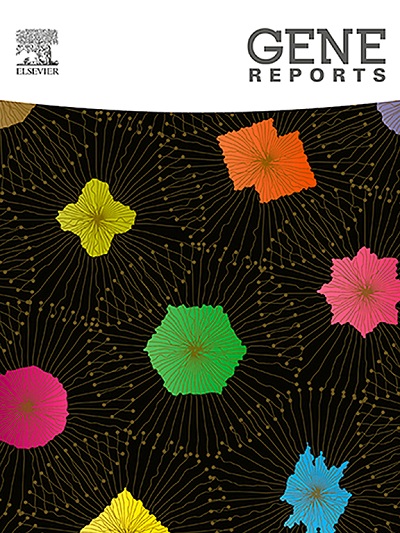Full blood chimerism and de novo crossover at HLA in a phenotypically normal 46,XY woman
IF 0.9
Q4 GENETICS & HEREDITY
引用次数: 0
Abstract
Background
The finding of a 46,XY karyotype in a female is a rare phenomenon in humans and generally associated with conditions that cause some sort of gonadal impairment. We report the first case of complete blood chimerism combined with HLA recombination and mismatch between tissues in a phenotypically normal, fertile and healthy woman.
Methods and Results
Samples from blood, urine, buccal swab and skin biopsy from the female proband were analyzed through cytogenetic techniques, HLA typing and STR analysis and then the results were compared to her male twin brother in an attempt to clarify the etiology of her 46,XY karyotype. The proband has had a completely normal life with no remarkable health events and a normal sexual development; she had an early pregnancy loss following a spontaneous pregnancy at the age of 35. Karyotype in two repeated blood analyses resulted in 46,XY in all metaphases; FISH confirmed this pattern by showing one X and one Y signal in all 100 cells analyzed. Cytogenetic analyses of urine, buccal mucosa and skin fibroblasts resulted in 46,XX. STR profile and HLA genotyping of proband's blood was completely identical to her twin brother's, including the sexual markers, carrying a recombinant maternal HLA haplotype in HLA-A, E, and H loci created by a crossover, and divergent from her other tissue samples.
Conclusions
The presence of different cell populations present in different tissues suggests that the proband is a chimera. Blood chimerism, also known as twin chimerism or transfusion chimerism, is a rare phenomenon in humans and may manifest without any sexual anomalies or reproductive impact. The newly formed MHC haplotype demonstrates that immunogenetic reshuffling in newborns may lead to long-term tolerance, providing new insight into the immunobiology of natural chimeras.
46,XY型正常女性HLA全血嵌合和新生交叉
在女性中发现46,XY核型在人类中是一种罕见的现象,通常与导致某种性腺功能障碍的条件有关。我们报告了一例完全血液嵌合结合HLA重组和组织之间的不匹配在表型正常,生育和健康的妇女。方法与结果通过细胞遗传学技术、HLA分型和STR分析对该女性先证者的血液、尿液、口腔拭子和皮肤活检样本进行分析,并与其男性孪生兄弟进行比较,以明确其46,XY核型的病因。先证者生活完全正常,无显著健康事件,性发育正常;她在35岁时因自然怀孕而早期流产。两次重复血液分析核型均为46,xy;FISH通过在所有被分析的100个细胞中显示一个X和一个Y信号证实了这种模式。尿液、口腔黏膜和皮肤成纤维细胞的细胞遗传学分析结果为46,xx。先证者血液的STR谱和HLA基因分型与其孪生兄弟完全相同,包括性别标记,在交叉产生的HLA- a、E和H位点上携带重组母体HLA单倍型,与其他组织样本不同。结论先证者在不同组织中存在不同的细胞群,提示其为嵌合体。血液嵌合,也称为双胞胎嵌合或输血嵌合,是一种罕见的人类现象,可能没有任何性异常或生殖影响。新形成的MHC单倍型表明,新生儿的免疫遗传重组可能导致长期耐受性,为自然嵌合体的免疫生物学提供了新的见解。
本文章由计算机程序翻译,如有差异,请以英文原文为准。
求助全文
约1分钟内获得全文
求助全文
来源期刊

Gene Reports
Biochemistry, Genetics and Molecular Biology-Genetics
CiteScore
3.30
自引率
7.70%
发文量
246
审稿时长
49 days
期刊介绍:
Gene Reports publishes papers that focus on the regulation, expression, function and evolution of genes in all biological contexts, including all prokaryotic and eukaryotic organisms, as well as viruses. Gene Reports strives to be a very diverse journal and topics in all fields will be considered for publication. Although not limited to the following, some general topics include: DNA Organization, Replication & Evolution -Focus on genomic DNA (chromosomal organization, comparative genomics, DNA replication, DNA repair, mobile DNA, mitochondrial DNA, chloroplast DNA). Expression & Function - Focus on functional RNAs (microRNAs, tRNAs, rRNAs, mRNA splicing, alternative polyadenylation) Regulation - Focus on processes that mediate gene-read out (epigenetics, chromatin, histone code, transcription, translation, protein degradation). Cell Signaling - Focus on mechanisms that control information flow into the nucleus to control gene expression (kinase and phosphatase pathways controlled by extra-cellular ligands, Wnt, Notch, TGFbeta/BMPs, FGFs, IGFs etc.) Profiling of gene expression and genetic variation - Focus on high throughput approaches (e.g., DeepSeq, ChIP-Seq, Affymetrix microarrays, proteomics) that define gene regulatory circuitry, molecular pathways and protein/protein networks. Genetics - Focus on development in model organisms (e.g., mouse, frog, fruit fly, worm), human genetic variation, population genetics, as well as agricultural and veterinary genetics. Molecular Pathology & Regenerative Medicine - Focus on the deregulation of molecular processes in human diseases and mechanisms supporting regeneration of tissues through pluripotent or multipotent stem cells.
 求助内容:
求助内容: 应助结果提醒方式:
应助结果提醒方式:


